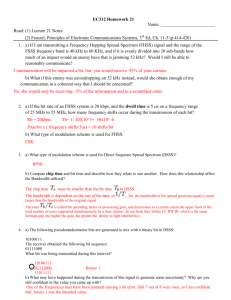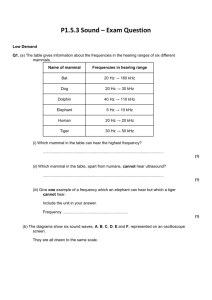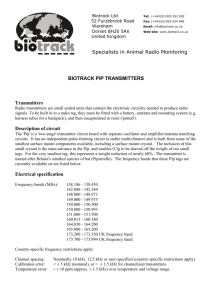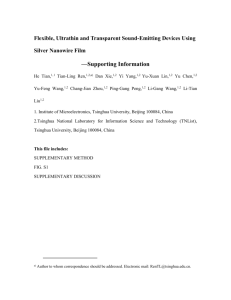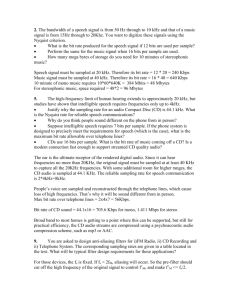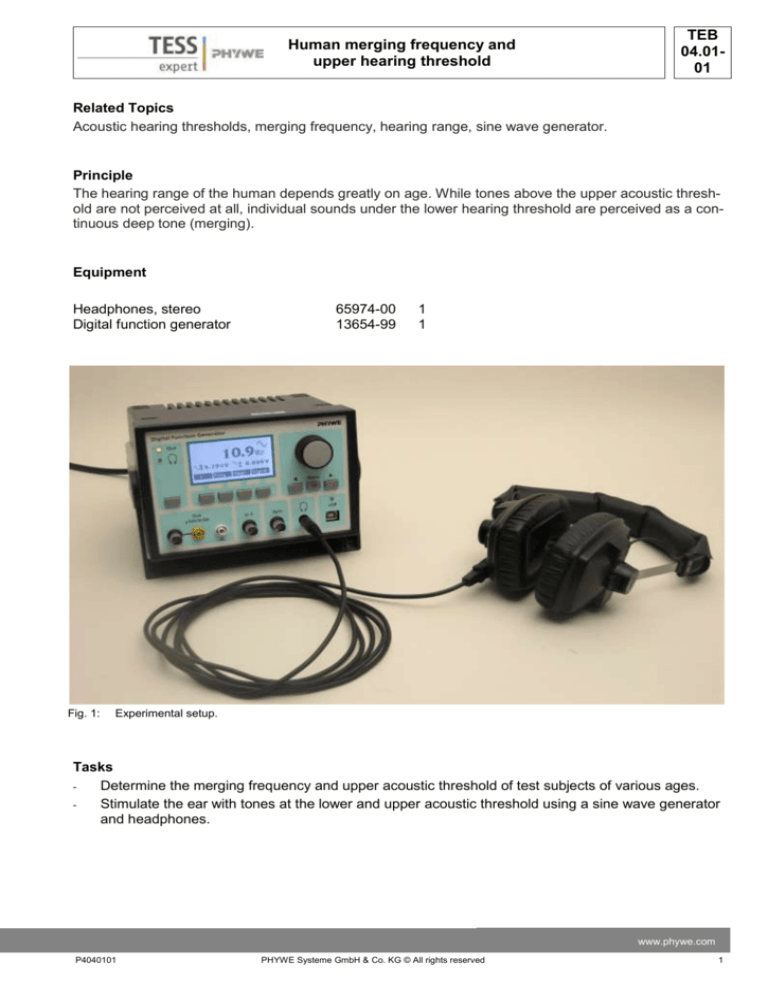
Human merging frequency and
upper hearing threshold
TEB
04.0101
Related Topics
Acoustic hearing thresholds, merging frequency, hearing range, sine wave generator.
Principle
The hearing range of the human depends greatly on age. While tones above the upper acoustic threshold are not perceived at all, individual sounds under the lower hearing threshold are perceived as a continuous deep tone (merging).
Equipment
Headphones, stereo
Digital function generator
Fig. 1:
65974-00
13654-99
1
1
Experimental setup.
Tasks
Determine the merging frequency and upper acoustic threshold of test subjects of various ages.
Stimulate the ear with tones at the lower and upper acoustic threshold using a sine wave generator
and headphones.
www.phywe.com
P4040101
PHYWE Systeme GmbH & Co. KG © All rights reserved
1
TEB
04.0101
Human merging frequency and
upper hearing threshold
Set-up and Procedure
-
-
-
-
-
-
The amplitude should be adjusted 0 before switching the instrument on to avoid surprising effects,
such as a loudspeaker sound pressure that is too loud.
The digital function generator is set up and switched on in a room that is as quiet as possible. Set
the function to sine and frequency to 20 kHz. Change the output to headphones, connect the headphones
Set the signal amplitude to maximum.
Place the headphones on the head of the test subject.
The leader of the experiment gradually reduces the frequency until the test subject just hears the
sound. The measurement is recorded. To prevent personal influence, the test subject must not be
able to see the digital display during the measurement procedure. The measurement should be repeated several times with the same test subject.
The frequency is set to 10 Hz. The leader of the experiment gradually increases the frequency until,
according to the test subject, the individual sounds merge into a continuous tone. This merging frequency is recorded. The measurement is repeated several times with the same test subject.
The upper acoustic threshold and merging frequency should, for comparative purposes, also be determined in younger and older test subjects according to the procedure described above.
The use of a loudspeaker instead of headphones certainly has the advantage that the measurement
can be carried out on many test subjects simultaneously, but the method is not recommended since
standing waves form in the experimental room. As a result, with a constant frequency and amplitude
the tone is heard with different degrees of loudness depending on whether the ear is near a wave
centre or near a wave node.
Theory and Evaluation
The human ear perceives sounds only within a very specific frequency range. Animals also have a typical hearing range, and even vertebrates may have ranges differing very considerably from the human
range:
goldfish
frog
chaffinch
cat
bat
whale
up to 4 kHz
30 Hz to 15 kHz
200 Hz to 29 kHz
up to 50 kHz
up to 90 kHz
up to 150 kHz
In man, the upper acoustic threshold depends greatly on age. The mean values for the measurements
undertaken should correspond roughly to the values in the following table:
up to:
16 years
20 years
35 years
50 years
70 years
90 years
2
20 kHz
18 kHz
15 kHz
12 kHz
9 kHz
5 kHz
PHYWE Systeme GmbH & Co. KG © All rights reserved
P4040101
Human merging frequency and
upper hearing threshold
TEB
04.0101
When the upper acoustic threshold is exceeded there is no longer any stimulation of the sensory cells
even with maximum sound intensity. When the lower limit is undershot, however, individual sounds remain audible. Nevertheless, the lower acoustic threshold can readily be determined since in this case the
individual sounds change to a continuous deep tone (merging); it is thus best termed the merging frequency. This frequency is independent of age and lies between 16 and 20 Hz.
www.phywe.com
P4040101
PHYWE Systeme GmbH & Co. KG © All rights reserved
3



